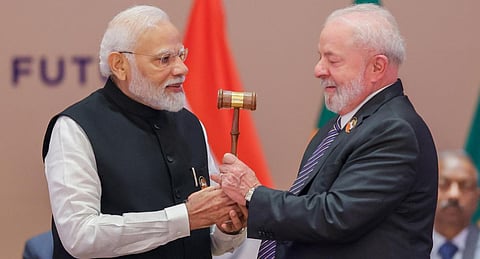

This is not a G20 world. Over the past several months, the expanded group of leading economies has gone from a would-be concert of nations to a cacophony of competing voices, as the urgency of the financial crisis has waned and the diversity of political and economic values within the group has asserted itself.”– Ian Bremmer and Nouriel Roubini, A G-Zero World, January 31, 2011
With the 18th iteration of the G20 over, we should extricate ourselves from the seductive fug of exorbitant bling and pomp of this annual meeting of cheerful heads of state, and come to terms with whether or not this soirée of august luminaries from across the ideological divide serves its purpose of global guidance and decision-making for a better future.
Many, including I, would say not—that it is a jamboree for geo-schmoozing. Host cities are cosmetically done up with multimillion-dollar infusions of transient beautification, urban presentability for two days, which are then ignored by visiting masters of the universe types, hurrying through lunches and dinners and conferences and arranged touristic excursions.
The G20 wasn’t always this fraught with controversy. It began promisingly enough. In 2008—the year the global economic megacrisis broke and the G20 became a heads-of-state huddle—and 2009, there was a consensus on instituting spending measures of USD 4 trillion to revive economies, work around trade barriers, and implement extensive financial sector reforms.
This consensus broke in a year. In 2010, the G20 began fraying at the seams as each member country chose to follow its own development piper instead of jamming together for a common purpose, which would have hobbled some countries while boosting others. As economic and environmental crises have become more and more local, even hyperlocal, global priorities have thereafter routinely been backbenched.
The European Parliament’s briefing body, the Think Tank, reported on September 8, 2023 that “the outcomes of recent summits have not been as clear-cut and unanimous as in previous crises (such as in 2008)”.
One argument goes that perhaps the G20 summits are too focused on finance and debt. The opposite argument, born in recent years with the rising self-iconisation of the political heads of countries both democratic and autocratic, chasing after populism, is that the G20’s remit has been made too large, too thinly spread, too diverse, with too many agendas and interest groups. It has no continuation of focus from year to year.
Take India’s priorities at the just-ended G20 summit in New Delhi, in the words of the Union Minister of State for External Affairs, V Muraleedharan: “inclusive and resilient growth; progress on sustainable development goals; green development and Lifestyle for Environment; technological transformation and public digital infrastructure; reforming multilateral institutions; women-led development; international peace and harmony”, and “digital public goods, just energy transition, health, education and employment”.
It’s an impossible task, politically buzzworthy but infinitely difficult to impose or organise. In the event, the G20 New Delhi Leaders’ Declaration is a catch-all, mention-everything document with no focus and no real intent, other than reaffirming Narendra Modi’s fixation with the number one: ‘One Earth, One Family, One Future’, in line with his ‘One Nation, One Election’.
But the family was divided. The jamboree ended without the traditional family photo. Several Western leaders didn’t want to be seen with a Russian official. It was that stunningly anodyne.
Analyst Seshadri Kumar listed the big jumble of ideas in a staccato manner in an online post, The New Delhi Declaration of G20 — Or, What a Unanimous Declaration Looks Like in a Divided World:
It was an exorbitant party. India blew Rs 4,110 crore on the two-day summit, compared to Indonesia’s Rs 364 crore in 2022, Japan’s Rs 2,660 crore in 2019, Argentina’s Rs 931 crore in 2018, Germany’s Rs 642 crore in 2017, Australia’s Rs 2,653 crore in 2014, Russia’s Rs 170 crore 2013, France’s Rs 712 crore in 2011, and Canada’s Rs 465 crore in 2010.
How much of this expenditure percolated down? Is this here-today-gone-tomorrow expenditure? The New Delhi Traders Association determined that shops and restaurants lost Rs 400 crore because of how the city was locked down for the three days of the summit. India had an outlay of Rs 990 crore for it. The estimated cost was overshot by 420%.
If anything has come out of such extravaganzas over time, it isn’t evident in the degrading environment, the exponentially growing rich-poor divide, the escalating sociopolitical barbarism at the gates.
Kajal Basu
Veteran journalist